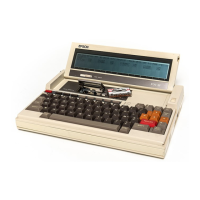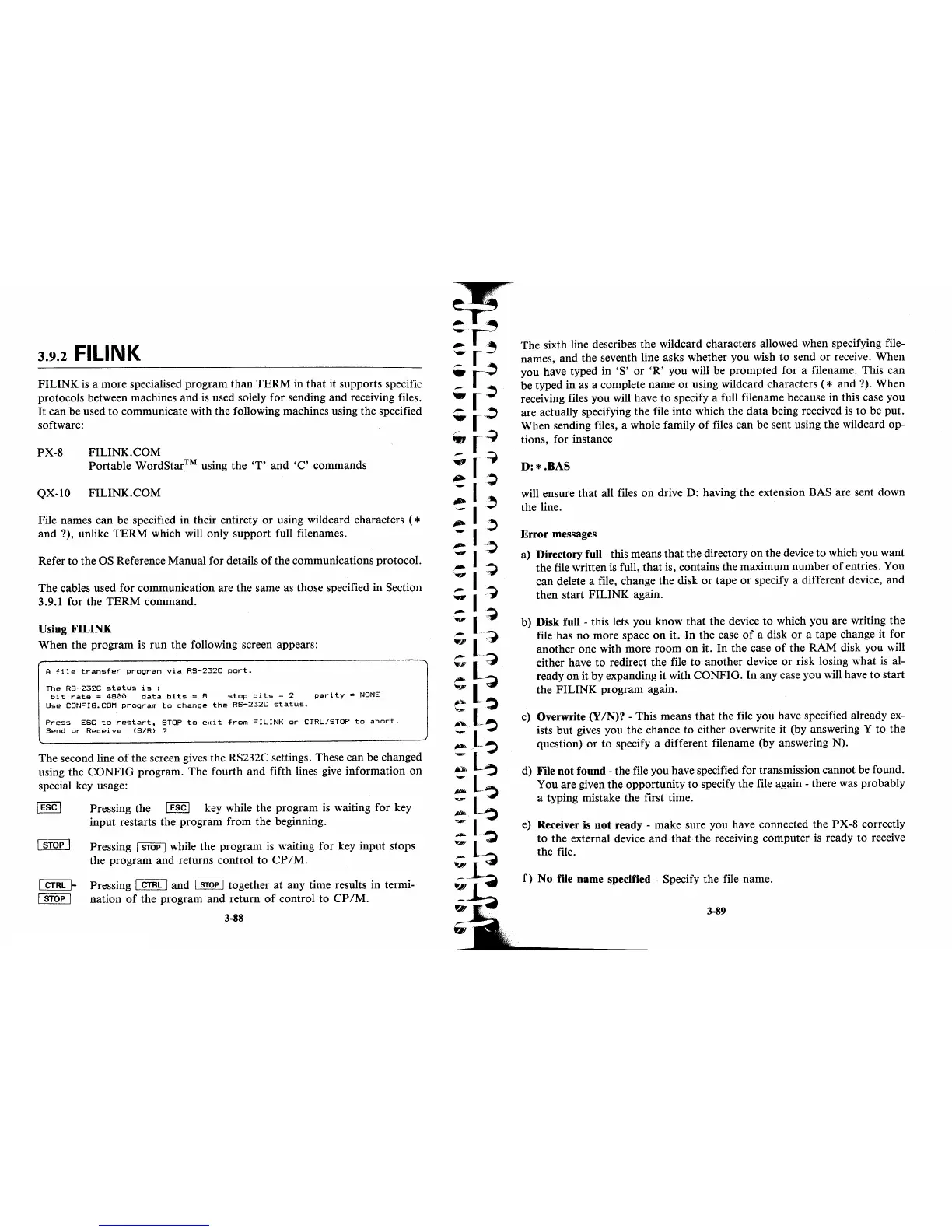3.9.2 FILINK
FlUNK
is
a more specialised program
than
TERM
in
that
it supports specific
protocols between machines and is used solely for sending and receiving files.
It
can be used
to
communicate with the following machines using the specified
software:
PX-8
FlUNK.
COM
Portable
WordStar™
using the
'T'
and
'C'
commands
QX-lO
FIUNK.COM
File names
can
be specified in their entirety
or
using wildcard characters
(*
and
?), unlike
TERM
which will only support full filenames.
Refer
to
the OS Reference Manual for details
of
the communications protocol.
The cables used for communication are the same as those specified in Section
3.9.1 for the
TERM
command.
Using
FILINK
When the program
is
run
the following screen appears:
A
file
transfer
program
via
RS-232C
port.
The
RS-232C
status
is
:
bit
~ate
=
4800
data
bits
= 8
stop
bits
= 2
pa~ity
=
NONE
Use
CONFIG.COM
program
to
change
the
RS-232C
status.
Press
ESC
to
restart,
STOP
to
exit
from
FILINK
or
CTRL/STOP
to
abort.
Send
or
Receive
(SIR)?
The second line
of
the screen gives the RS232C settings. These can be changed
using the
CONFIG
program. The fourth
and
fifth lines give information
on
special key usage:
Pressing the
I ESC I key while the program
is
waiting for key
input restarts the program from the beginning.
Pressing
I STOP I while the program is waiting for key input stops
the program and returns control
to
CP
1M.
Pressing I
CTRL
I and I
STOP
I together
at
any time results in termi-
nation
of
the program and return
of
control
to
CP
1M.
3-88
The
sixth line describes the wildcard characters allowed when specifying file-
names, and the seventh line asks whether you wish
to
send
or
receive. When
you have typed
in'S'
or
'R'
you will be prompted for a filename. This can
be typed in as a complete name
or
using wildcard characters
(*
and ?). When
receiving files you will have
to
specify a full filename because in this case you
are actually specifying the file into which the
data
being received
is
to
be put.
When sending files, a whole family
of
files can be sent using the wildcard op-
tions, for instance
D:*.BAS
will ensure
that
all files
on
drive D: having the extension BAS are sent down
the line.
Error
messages
a) Directory full - this means
that
the directory
on
the device
to
which you want
the file written
is
full, that is, contains the maximum number
of
entries. You
can delete a file, change the disk
or
tape
or
specify a different device,
and
then start
FlUNK
again.
b) Disk full - this lets you know
that
the device
to
which you are writing the
file has no more space
on
it.
In
the case
of
a disk
or
a tape change it for
another one with more
room
on
it.
In
the case
of
the
RAM
disk you will
either have
to
redirect the file
to
another device
or
risk losing what
is
al-
ready
on
it
by
expanding it with CONFIG.
In
any case you will have
to
start
the
FlUNK
program again.
c) Overwrite (YIN)? - This means
that
the file you have specified already ex-
ists
but
gives you the chance
to
either overwrite it (by answering Y
to
the
question)
or
to
specify a different filename (by answering N).
d) File not found - the file you have specified for transmission cannot be found.
You are given the opportunity
to
specify the file again - there was probably
a typing mistake the first time.
e) Receiver is
not
ready - make sure you have connected the PX-8 correctly
to
the external device and
that
the receiving computer is ready
to
receive
the file.
f)
No file name specified - Specify the file name.
3-89

